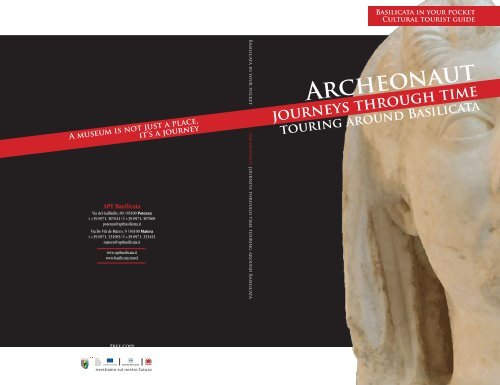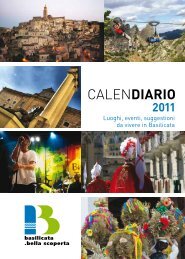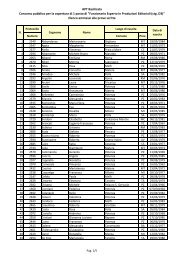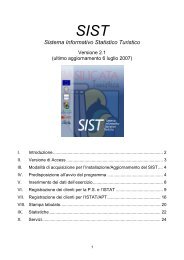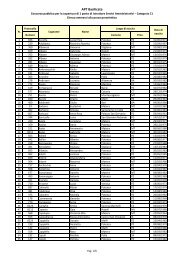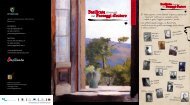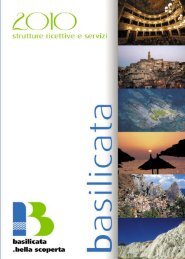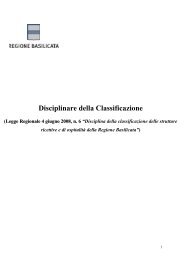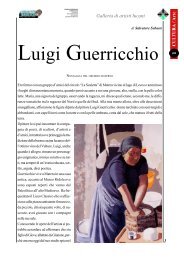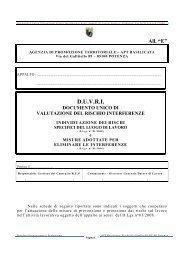Archeonaut - APT Basilicata
Archeonaut - APT Basilicata
Archeonaut - APT Basilicata
- No tags were found...
You also want an ePaper? Increase the reach of your titles
YUMPU automatically turns print PDFs into web optimized ePapers that Google loves.
<strong>Archeonaut</strong>journeys through timetouring around <strong>Basilicata</strong>TextsMargherita RomanielloEditorial managerMaria Teresa LotitoEditorial assistance and supportAnnalisa RomeoEditorial projectMargherita Romaniello / Michele CignaraleConcept and layoutmichelecignarale.comPhotosApt <strong>Basilicata</strong> Archive /The <strong>Basilicata</strong> Architectural Heritage DepartmentMapsPowered by Google MapsPrintingBMG srl
Museums andArchaeological areas616243238445260667278848688PotenzaMateraVenosaMelfiMetapontoPolicoroMuro LucanoVaglioGrumentoMarateaBaragianoArchaeonaut RoutesGlossaryTravel Journal<strong>Basilicata</strong>,A LAND TO DISCOVER,TOGETHER WITH ARCHEONAUTA journey, an adventure and a story.<strong>Basilicata</strong>, discovered and rediscovered through its museums andarchaeological areas, provides visitors with fascinating places thathave been traversed by peoples, made sacred by gods and inhabitedby women and men with their activities, customs and fears.Routes traced out thousands of years ago are brought back to life,thanks to the discoveries of excavation campaigns that began over acentury ago, and moments of everyday life, captured in objects thatwere used for household activities, warfare, sacred ceremonies andrites of passage recover their true dimensions.Anyone who wishes to venture along the fascinating paths of ancienthistory in <strong>Basilicata</strong> will feel like an “archeonaut”, a traveller fromthe present who rediscovers the story of yesterday.With its rivers, which traverse it from the sea to the most hiddenheart of its lands, and its nature, at times generous and at timessevere, <strong>Basilicata</strong> has welcomed peoples, seen the rise and fall ofcivilisations, undergone invasions and given birth to myths.Its museums now house the precious relics of the past and itsarchaeological areas contain infinite stories, like open-air historybooks. These are the starting or finishing points for an exploration inwhich time is not a measure but a guide, and its tracks are fascinatingcompanions for the imagination of every visitor.
The“Dino Adamesteanu”NationalArchaeologicalMuseumVia Andrea Serrao - Palazzo Loffredo - tel (+39) 0971 323111opening times: Monday 2:00 – 8:00 pm;Tuesday - Sunday 9:00 am - 8:00 pmclosed weekly: Monday morningsProvincialArchaeologicalMuseumVia Ciccotti - tel (+39) 0971 444833Sunday and Monday 9:00 am - 1:00 pm;Tuesday - Saturday 4:00-7:00 pm (wintertime: 9.00-13.00)closed weekly: Monday afternoonsPotenzaThe “Dino Adamesteanu”National Archaeological MuseumThe National Archaeological Museum in Potenza, inaugurated inMay 2005, was named after Dinu Adamesteanu, the Romanianarchaeologist and undisputed father of archaeology in <strong>Basilicata</strong>.The desire to create a network of museums in <strong>Basilicata</strong>, in thoseplaces principally marked by the presence of Lucanian history andarchaeology, was mainly due to him.The two floors of the museum house a true archaeological anthologyof <strong>Basilicata</strong>: an adventure of peoples, both Hellenic and non-Hellenic(and then indigenous and Roman) which can be seen in the displaycabinets, in the reconstructions of buildings and tombs, and in thedescriptions on the panels that guide the tours of the museum.Following a chronological plan, the museum guides the visitorthrough its halls among archaeological records gathered from thecountless excavation campaigns that have been organised throughout<strong>Basilicata</strong>.It is an anthology of epic events and common people, of kings andprincesses, of materials that were brought from afar (such as theamber from the Baltic and bronzes from the Etruscan world) andobjects created by the hands of local craftsmen.The pre-colonisation phase, the indigenous presence of Oenotrians,Daunians and Peuketiantes, then the Greek colonisation, the presenceof the Lucanians, and lastly Romanisation are the fundamental stagesthrough which the history of <strong>Basilicata</strong> is presented at the DinuAdamasteanu Museum. The spectacle fibulas that the women usedto adorn their clothes, the armillas (bracelets) and gold and bronzependants, and the warriors’ swords discovered in pit graves in thehuge necropolises portray the Choni-Oenotrians who lived along theIonic coast (Santa Maria d’Anglona - the ancient Greek Pandosia)between the 5th and 8th centuries BC.The settlement at Incoronata di Pisticci (in Matera) has alsoproduced remains from the first phase of Greek colonisation. Theoldest decorated ceramics, on which skilled hands painted scenesof heroes and myths borrowed from Greek culture, date back to thisperiod.7
XXXXXXXXXXXXXXXXXXXXXXXXXXXXXXXXXXXXThere are some important 6th-5thcentury BC grave goods from the Braidadi Vaglio settlement, which can also betraced to basileis of the Peuketiantes.These include Greek and EtruscanCampania-produced bronze tableware,as well as implements used in banquets,moments of joyful gathering anddecidedly male politics. There arehuge meat cauldrons (lebeti), roastingskewers, tripods and vessels for mixingand drinking wine (kraters), andceremonial trappings for horses andriders that recreate the scene of anindigenous world in which differencein rank was truly expressed in everydetail.The Lucanians were people of Osco-Sabellian stock that arrived in theinternal areas of <strong>Basilicata</strong> towardsthe end of the 5th century. Their highground positions, which were providedwith fortifications (each within visiblecommunication range of the next),and the most important worship siteof their Olympus, the Rossano diVaglio sanctuary, have been broughtback to life in the museum throughThe “Braida”Exhibition Roomin VaglioThe NationalArchaeologicalMuseum in Potenzathe reconstruction of their sanctuarycourtyard. Rich votive gifts werediscovered there, including smallstatues, jewels and miniature vesselsdonated to the goddess Mefitis, whowas venerated together with the godMamerte (the Mars of the Lucanians).Mefitis was the goddess of springs andnature, and of the living and the world ofthe dead. When the “Lucanians becameRomans”, Roman dominion wasimposed on the indigenous settlementsand the two major centres, Grumentumand Venusia, arose. The transformationsof the territory and the cultural fusionsin the areas involved can be seen fromthe grave goods and remains recoveredin the patrician residences. The sectionof the museum dedicated to Roman<strong>Basilicata</strong> can be identified particularlyby the colour of its walls. Pompeian red,reminiscent of the Villa of the Mysteries,together with an image of maenads fromthe Dionysian procession and the verseof Horace, the Latin poet who was bornin Venusia, introduce the phase thatbegan in the 3rd century BC and lasteduntil late antiquity.Embossed bronze platedepicting Amphitrite ridinga dolphin, from Rossano diVaglio10 11
ovincialArchaeological MuseumWe are welcomed by a goddess seated ona throne, like a priestess. She must oncehave held a baby in her hands. Behindher is the temple, which was probablydedicated to her.This is the Temple of Garaguso, namedafter the location in which it wasdiscovered and where it was kept from400-470 BC.This is the symbol of the ProvincialArchaeological Museum in Potenza,which housed all the archaeologicalremains recovered in the provincialcapital before the opening of theNational Museum.Temple and goddessfrom Garaguso 480-470 BCAn acroterium from Vaglio12The acroterion, an architectural featureplaced at the apex of the roof, wasunearthedin Serra di Vaglio and can be dated tothe 4th century BC.It represents the Medusa, daughterof Phorcys and Keto, the only mortalamong the Gorgons, who turnedwhoever looked at her into stone. Shehad serpents in her hair as a sign ofpunishment from Athena for having metPoseidon in front of her temple.Medusa was killed by Perseus, whomanaged to cut off her head with aknife and a magic shield given to himby Athena. Myth has it that Medusa’sblood, which was spilt on the coucheslaid on the beach where Perseus rested,produced coral.
How to get to PotenzaBY TRAINInfo: www.trenitalia.comBY AIRNAPLES AIRPORT distance: 150 km. Info: +39 081 7896111BARI AIRPORT distance: 150 km. Info: +39 080 5835200BY CARA3 SALERNO-REGGIO CALABRIA take the Sicignano exit and then continue along theSS Basentana until the Potenza centro exitA1 FLORENCE-ROME: proceed until Caserta, take the A30 Caserta-Salerno motorway,then the A3 Salerno-Reggio Calabria, exit at Sicignano and then continue along the SSBasentana until the Potenza centro exitInfo: www.autostrade.itBY BUSwww.ibus.itNational andProvincial MuseumPotenzaGPS: N 40° 38’ 39’’ E 15° 48’ 30’’14 15
The “Domenico Ridola” NationalArchaeological Museum in MateraThe oldest archaeological Museum in <strong>Basilicata</strong>(established in 1911) welcomes us in a formerClarissian convent, which was enlarged to housethe numerous findings from excavation campaignsin the territory of Matera and the province.The“Domenico Ridola”NationalArchaeologicalMuseum inMateraVia Ridola, 24 Tel. (+39) 0835.310058Opening times: Monday 2.00 – 8.00 p.m.;Tuesday - Sunday 9:00 am - 8:00 pm;Closed weekly: Monday morningsOne of the oldest sites in the world, inhabitedwithout interruption from prehistoric timesuntil the present, Matera is viewed through therudimentary arms made from ferns and obsidians,and then through ceramics that at first werebarely shaped and then became evermore finelydecorated until the breakthrough of black- andred-figure painting on vessels for banquets,weddings and funeral rites.In a passageway between caves that were inhabitedin prehistoric times, reconstructed in the new hallsof the museum, you will encounter the difficultbut ingenious art of survival practiced by people6,000 years ago, who practiced shepherding andagriculture.Welcomed by a wealth of ceramics of variousdifferent shapes, which were used in banquetsand libations as well as sacred ceremonies(purification, nuptial and funeral rites), we areimmersed in the smells, noises and probably notso-healthyenvironment of the ceramic workshopsfrom the golden era of Greek colonisation, whenthe abilities of the mother country (Attic Greece)blended harmoniously with the manual skills ofthe colonies.Red-figure kratersfrom the RizzonCollection4th century BC17
To have an idea of what it meant fora woman in 6th-century BC Greekculture to adorn herself for marriageto her beloved, to be purified andpurify a dead body or take part in aDionysian banquet, you just have tovisit the abundant “Rizzon Collection”.This includes 74 pieces, of Apulian andLucanian manufacture, with unusualand precious shapes, attributed by theexperts to the mastery of the so-calledateraOnce againPisticci Painter and hisdisciple, the Amykos Painter, and other4th-century BC painters. The figuresimmortalised on the sides of the winekraters (large vessels for mixing winewith water and spices), oinochoes(jugs for pouring wine), bowls andcups present settings and scenes ofdaily life, the gynoecium, departuresand returns home, Dionysian feasts andthe monstrous animals that inhabitedthe imaginary afterlife of the Greeks.Eros looks at me languidlyfrom under sultry eyelidsand with his various charms tosses meinto the boundless net of Cypris(Ibycus of Rheggium 6th century BC)The “Domenico Ridola”National Archaeological Museum:interiorRed-figure pelike5th century BC18 19
ateraFROM THE SCALPEL TOEXCAVATIONDomenico Ridola was a doctor andsenator of the Kingdom of Italy, aswell as a passionate archaeologist whounderstood the enormity and value ofthe treasures hidden in the territoryof Matera. He even launched the firstsuccessful excavation campaigns onTimmari hill and in Montescaglioso (15km from Matera), where a sanctuarydedicated to Greek divinities, includingDemeter, Persephone and Aphrodite,was discovered.Domenico Ridola ardently desired thatthe numerous findings unearthed duringthe various excavation campaignsshould be granted a permanent home.In 1911 he requested that Materabe provided with an ArchaeologicalMuseum; his request was granted, andtoday the museum bears his name.Domenico Ridola’s studio has beenreconstructed in one of the halls in themuseum, with its original furnishingsand detailed sketches and notesproduced by his own hand.Neolithic painted bowlThe “Ridola” studio room20 21
The <strong>Archeonaut</strong> and the Picture StoryVessels, jars, jugs andchalices can all seem thesame in the end. However,those that form partof the Rizzon collection(named after the Apuliancollector, Paolo Rizzon) arequite breathtaking.Acquired by the state in1990 and intended for theDomenico Ridola Museum,this marvellous collection ofred-figure Daunian vessels,with the most incredibleshapes, presents stories,generic scenes, romanticmeetings and greetings in akind of 2,500 year-old soapopera. The scenes depictedmostly feature myths, deitiesand sea monsters, but alsohave epic heroes, younglovers, valiant warriors,anxious wives and sturdyyouth.How to get to MateraBY TRAINChange at Bari 60 km from Matera Info: www.trenitalia.comBY AIRBARI-PALESE AIRPORT 50 Km from Matera Info: (080) 5835200BY CARA14 BOLOGNA-BARI exit at Bari Nord and take the first exit (Zona Industriale)immediately after the motorway toll gateA1 FLORENCE-ROME: proceed as far as Caserta, take the A30 Caserta-Salernomotorway, then the A3 Salerno-Reggio Calabria, exit at Sicignano-Potenza andthencontinue towards MateraA3 Salerno-Reggio Calabria: take the Sibari exit, and then proceed along the SS.106 Ionica Metaponto-Matera Info: www.autostrade.itBY BUSwww.ibus.itNationalArcheological MuseumMateraGPS: N 40° 40’ 6’’ E 16° 36’ 5’’Sea monsters and winged figuresin red-figure on rythonsTimmari (Matera)The Rizzon Collection22 23
The“Castello Pirro del Balzo”Archaeological Area andNational Museum inVenosaPiazza Castello - Castello Pirro del Balzo - tel (+39) 0972 36095Opening hours: Monday, Wednesday, Sunday 9:00 am – 8:00 pm;Tuesday 2:00 – 8:00 pm - Closed weekly: Tuesday morningsThe “Castello Pirro del Balzo”Archaeological Area andNational Museum in VenosaVENOSA, THE COLONY DEDICATEDTO THE MOST BEAUTIFUL GODDESSLoreto and Notarchirico, the prehistoric parks, are twostarting points for a 600 thousand-year journey. Venosa,the city that owes its name to the goddess Venus, wasthe Latin colony that marked a fundamental stage in thehistory of <strong>Basilicata</strong> and whose origins are very ancient.From Palaeolithic times until the present, evidencepreserved in the fossils of bisons, elephants and deer,and also plants that today are extinct, indicates placesthat were once characterised by lakes and forests.This was home to Homo erectus 300 thousand yearsago, who hunted, tanned hides and knew how tomake cheese. His main implements were pointed flintstones, spears, cups, javelins, strainers and funnels.These must have been used by the men and also thewomen, from one of whom a thigh bone was found, theoldest in southern Italy, which is now displayed in theArchaeological Museum.Prosperity came to these places in the north of <strong>Basilicata</strong>through the via Appia, the most famous consular route,which linked Rome with Brindisi, the most importantport towards the east and the culture of Athens. Venusiawas established in 291 BC, along the “regina viarum”(as the Appia was known) and its 40 hectare site wassoon populated. This corresponds to what is today thelocation of the Abbey of the most Holy Trinity as far asthe castle in Pirro del Balzo, in whose courtyard thecastellum acquae, which provided the water supply forthe entire colony, was rediscovered.Archaeological museumand theIncompiuta complex25
enosaVenosa enjoyed fortune and prosperityfrom the Republican period to the DarkAges, with otium and negotium, affairsof state and amusements, of which theVenusians, like the Romans of the Citywere also untiring enthusiasts. Perhapsthe baths were the best indication of thedegree of Romanisation in the variousplaces throughout the Empire, andVenosa was not found wanting in thisrespect. The dolphins and moray eelsthat swim in the waters of a mosaicsea on the floor of the frigidarium arereminiscent of the bodies of bathingmen intent on discussing politicalaffairs, business and programmes forthe evening in this peaceful colony ofRegion II of the Empire.The spa complex in Venosa invites usto imagine the vapours that rose fromthe praefurnia, where wood was burntthat released hot air, towards the tubsof the calidarium, or to picture thedaily life that went on in the variousdomus not far from the baths. But theNational ArchaeologicalMuseum, interiorVenosians also loved gladiatorial gamesand the animal hunts (venationes) thatwere staged in the Amphitheatre, whichtoday is separated from the ancient cityby the provincial road. This dates to the1st century AD and is divided into threesections, known as caveas: the ima(lowest), the media and the summa.A funerary monument is still visiblealong the via Appia that, according tothe sources, is the tomb of the consulClaudio Marcello, who died in 208 BCbetween Venosa and Banzi (the RomanBantia) during the 2nd Punic war.Ancient Venusia can be partiallydiscerned today by walking aroundthe archaeological area, alongsidethe Incompiuta monumental complexand the Abbey of the Trinity. The threelevels of the Abbey’s construction weavea thread of a history that begins inthe 5th century AD and arrives at theMiddle Ages, when it received the bodyof Robert Guiscard, the founder of theNorman kingdom.Tu ne quaesieris, scire nefas, quem mihi, quem tibifinem di dederint, Leuconoe (…)dum loquimur, fugerit invidaaetas: carpe diem quam minimum credula postero.THE SINGER OF CARPE DIEMHe was only 10 years of age when hisfather, a freedman (emancipated slave),sent him to Rome; but Quintus HoratiusFlaccus always kept Venosa, where hewas born in 65 BC, in his memory.In his odes he celebrates the places ofhis birth, remembering the sweetnessof its woods, around Mount Vulture,where as a child he hid to escape from(Aus den Oden. Quinto Orazio Flacco)Do not ask, for it is not granted to knowwhat will be my destiny or yours (...)as we speak envious time already fleesgrasp the moment and believe as little as youcan in the future.Statue of Quintus Horatius Flaccus in Venosahis nursemaid.Horace drifts through the historiccentre of Venosa, in a literary journeythat evokes his verse, his precepts oflife, his melancholy, his friendship withMecenate and Augusto, and his searchfor the “aurea mediocritas”, simpleharmony in all things.26 27
Jewish Catacombs:a coexistence virtuous exampleThe original core of Venosa’s Jewishcolony was established immediatelyafter the destruction of the JerusalemTemple (70 AD) by the Emperor Titus,as stated in documents concerningRegion II, of which the colony formedpart. The Jews had probably comehere previously as workers and thenacquired wealth and therefore powerwithin the Latin community, of whichthey became an integral part. All ofthis is indicated by the tombs andcatacombs in Venosa, which form oneof the most important complexes afterthose of Rome. After various collapses,landslides and damage (the hill of theMaddalena under which the catacombswere excavated is extremely friable),today the Jewish catacombs of Venosaare open once more and may bevisited.From the central corridor, alongwhich a wooden gangway protects theunderlying tombs from being trampledon, graffiti is visible on some of thetombs. Inscriptions in ancient Greekidentifythose deposed there, such as the clearlylegible Tafós Mercorios, or “tomb ofMercorios”. In a magnificent frescoedarcosolium (an arched niche used as atomb), unearthed in an area that is nolonger accessible, and reconstructedalong the corridor, there are symbolsdrawn from the bible: the sevenbranchedcandle holder, the menorah,a horn, a palm branch, a cedar and anamphora. The abundant decoration andthe precious marble that once coveredthe tomb indicate a high rankingburial.The importance of the Jewish catacombsin Venosa, which is mentioned upuntil the 7th century AD, can be seenfrom the many inscriptions in the tuffstone of the tombs, which mentionpresbyters (members of the Council),archisynagogues, gerusiarchs (heads ofthe elders), and also archiatri (doctors),patres and their wives, pateresse. Oneof the funerary inscriptions remembersthe “pateressa” (wife of the “pater”)Alessandra, and the rich and powerfulAussanius and Marcellus. We have tracesof these, and of many others we do not,but the Jews in Venosa must have beeninfluential as well as numerous.They were therefore important people,well-integrated and socially relevant, ina context of cohabitation that can alsobe seen from the tombs. Here in Venosa,Jews and Christians were buried inadjacent spaces after their bodies werepurified in the waters of the nearbyReale and Fiumara streams.Jewish catacombs28 29
How to reach VenosaBY TRAINInfo: www.trenitalia.comBY AIRFOGGIA AIRPORT 50 Km from Venosa Info: +390 0881 619021BY CARA14 BOLOGNA-BARI Candela exit heading towards Melfi immediately after the motorwaytoll gate. Continue along the SS 658 and the SS 655, Venosa exitA3 Salerno-Reggio Calabria, exit at Sicignano-Potenza and then continuealong the SS 655 Venosa exitInfo: www.autostrade.itBY BUSwww.ibus.itArchaeological Areaand National MuseumVenosaGPS: N 40° 57’ 40’’ E 15° 48’ 53’’The head of a marble statueportraying a Diadumenos 2nd century AD30 31
The “Massimo Pallottino”Archaeological Museum in MelfiThe“Massimo Pallottino”Archaeological Museum inMelfiVia Castello – Tel. (+39) 0972 238726Opening hours: Monday 2:00 pm – 8:00 pm;Tuesday -Sunday 9:00 am – 8:00 pmClosed weekly:Monday morningsThey feared the unknown and sought toexorcise the darkness beyond the tombthrough recourse to immortality.They were refined, lovers of beauty andrespectful towards the gods. This is theimpression of the people who lived inthe territory north of <strong>Basilicata</strong> betweenthe 7th and 3rd century BC provided bythe abundant possessions in their tombs.These are reconstructed in the halls ofthe Melfi Archaeological Museum, hometo a collection of shining armour, finejewels and objects that indicate a timebelonging to men, women, children andpriests.Melfi enjoyed a strategic position,bordering with the flourishing Dauniaand traversed by rivers that, like themotorways of antiquity, enabled contactwith the Etruscan Campania area andthe Ionian Coast, which had just beencolonised by the Greeks.These favourable geographicalcoordinates convinced the EmperorFrederick II to choose Melfi as the siteof one of his castles and the place fromwhich, in1231, he promulgated the“Melfitan Constitutions”, a body of lawsthat remained in force until the modernera.The tombs reconstructed in the variousrooms of the Museum bring to lifevaliant warriors buried with their lances,their armour (helmets, greaves, fittedbreast-plates, belts and shields) andobjects representing the social level ofthe deceased. These include banquetingsets with bronze bowls for boiling meat,evidence of contact with the Etruscanpopulations in Campania, skewers,Corinthian-made drinking vessels,indicating relations with the people ofGreek stock that had settled from 640 BCalong the Ionian coast (Metapontum),wine craters, ollas (large earthenwarecontainers for holding and conservingfood products) and ladles.The ceramics from Canosa are unique(the tradition of ceramic manufacturein Puglia has very ancient origins), withvessels distinguished by the presence offemale faces of different sizes on theirhandles or extremities, the liturgy ofbanquets and their social value.33
If, as we read in the writings ofQuintus Horatius Flaccus, “muchreaping is done in war, but always fora very meagre harvest”, what has beengathered from the art of war in thismuseum, however, gives the impressionof riches and power.The armour of the warrior leaders,who with both Daunians and Lucaniansstarted as hoplites (infantry soldiers)and then became horsemen, arethere to welcome visitors, proud andsplendid like those who must haveworn or commissioned them.elfiEven the horses had to follow theirowner’s tone of command andwere decorated with bronze masks(prometopidia) and ceremonialbreastplates. In order to reaffirm thedead warrior’s importance, he wasalso often buried with weapons thatwere part of the spoils of war as wellas his own. This can be clearly seen inthe museum, for example, in a tombthat was discovered in the locationof ancient Ferentum, the present-dayLavello, and has been reconstructedhere.“... After having laid them down and formed asymposium of the just, they see to it that theyspend all their time drunk and crowned withgarlands, considering perpetual drunkennessto be the highest reward for virtue”.(Plato, The Republic)MYTHICAL ABDUCTIONSIf you love someone, you will want tosave them at any cost, even from death.But this is not granted to humans,unless one is loved by a god, who wouldcertainly have some extra power.Italo-Chalcidianbronze helmet,Lavelloafter and beyond the tomb, also formedpart of the Greek world. The subjectof “salvific abduction” recurs oftenin the Greek world, as well as that ofthe indigenous peoples who came intocontact with it. This more than anythingelse is depicted on vessels and on somebronze ware, such as the Etruscanmaderitual candle stand in Ruvo delMonte, which features the scene of theimmortal Eos in the moment in whichshe abducts Kephalos on its cimasa(extremity).Eos, the goddess of the dawn, sister ofthe sun and the moon, who was in lovewith Kefalos, abducted him and took himaway in flight to remove him from theearthly world and transport him whereReconstruction of a wealthy tombhe could be nourished with immortality.with Daunian vases and weapons LavelloThe myth of salvation, the sense of a life34 35
BY TRAINInfo: www.trenitalia.comTHE ARCHEONAUT ANDHow to get to MelfiTHE ENCOUNTER WITH PYTHAGORASBY AIRFOGGIA AIRPORT 50 Km from Melfi Info: (0881) 619021BY CARA14 BOLOGNA-BARI Candela exit heading towards Melfi immediately after the motorwaytoll gate.A3 Salerno-Reggio Calabria, exit at Sicignano-Potenza and thencontinue towards MelfiInfo: www.autostrade.itBY BUSwww.ibus.itNationalArchaeologicalMuseum MelfiGPS: N 40° 59’ 47’’ E 15° 39’ 4’’Eos abducting Kephalos,detail from a bronze candleholder Ruvo del Monte36 37
TheArchaeologicalArea and NationalMuseum inMetapontoVia Aristea, 21 – Ortschaft Metaponto - tel. (+39) 0835 745327Öffnungszeiten: Montag 14.00 – 20.00;Dienstag – Sonntag 9.00 – 20.00 - Geschlossen: MontagmorgenThe Archaeological Areaand National Museum in MetapontoThe historian Strabo tells us thatMetapontum arose in the mid-8th centuryBC upon the ruins of a previous Greeksettlement (already in the locality; likeIncoronata di Pisticci and Siris itself, smallGreek communities had arisen built bypeople from the Peloponnese who hadcome in search of fertile lands).The Greek colony, in fact, was establishedin 630 BC.Who were its founders?They may have been part of the Achaeanarmy that had destroyed Troy, or commonpeople motivated by the prospect of abetter existence and probably sent to callother Achaeans already settled in Sibari.What is certain, however, is that they gaverise to a flourishing and productive colonythat always maintained contact with themother country.Metapontum (whose first name wasMetabos, like the hero, to whom asanctuary was also dedicated) arosebetween the mouths of two rivers, theBradano and the Basento. The newinhabitants gave it an urban connotation,provided it with perpendicular streetsand drained the countryside around it,creating a chora, or farming territoryenhanced by the necessary infrastructurefor the development of a colony: temples,theatres, sanctuaries and later on a fullyfledgedcraftwork district, just like inAthens: the kerameikòs.At first these places were inhabited by Choniand Oenotrians. These were, nevertheless,inhabitants of ancient Greek stock who hascome to this area of <strong>Basilicata</strong> a full “17generations before the war of Troy”, as weare informed by the historian Dionysiusof Alicarnasso. When Metapontum wasfounded, the area had already had a longexperience of men and women who livedbetween Incoronata, Termitito and othersites that have that have provided overthe course of the excavations weapons,utensils and jewels, as well as indicationsof how they must have lived, provided theirfood, understood the passage of time andthe events of daily life during the archaicera of this colony.The urban structure of Metapontumdisplays the typical signs of all the coloniesin Magna Graecia, inspired by the customs,rites and cults of the mother country.In the items they manufactured andin their architecture, the colonies thatwere first established there reproducedmodels from their places of origin; thenexchanges and comparisons with thelocal populations and those that hadarrived from the sea began, techniqueswere customised and life became dividedinto many activities that gradually made itmore refined and evolved.39
etapontoAN ARTISTOF TWO THOUSAND FIVE HUNDREDYEARS AGOMetapontum had its own craftworkdistrict, which like that of Athens wascalled the Kerameikòs, because it washere, far from the inhabited area, thatfired ceramics were created, shapedand then finely painted, in a specialarea known as an ergasterion (whichwe could consider as their studios).Some of them were not just craftsmen,but genuine artists: the painter ofAmykos (between the 5th and 4thNational Archaeological MuseumInteriorcentury BC) and the famous Pisticcipainter, considered as the leader of the“Lucanian” style of earthenware vesseldecoration. His skill, which perfectlyreproduced details, expressions andgestures with extreme care, was alwaysfocussed on mythological themes (hisdepiction of the birth of Pandora ona bell krater should not be missed)or abduction, like that of Egina byZeus, immortalised on the sides of ahydria (the classic vessel for carryingwater), or the equally touching one ofthe goddess Eos carrying her belovedKephalos up to heaven.“he was not in the habit of portrayingthe human figure, except for thosethat had merited immortality forsome illustrious reason, mainly forvictory in the sacred contests“.(Plynius)PYTHAGORAS, THE MYTHICAL FIGUREOF A STRICT TEACHERHopes of eternal salvation and thesearch for a life beyond this worldin Metapontum were combined withOrphic, Dionysian and Pythagoreantheories, which had made the souland its immortal journey one of thecornerstones of their life and thought.The origins of Pythagoras of Samosare legendary, as is the description ofhis appearance (tall, proud, dressed introusers, quite an unusual outfit amongthe Greeks, and he even had a goldenthigh). What is certain is that ourinformation about him has been handeddown to us by his disciples and greatthinkers such as Plato and Aristotle.He was a mathematician, philosopher,musician, teacher of life and, asLamblichus tells us in his writings, itMarble bust ofthe heroAlexidamosseems he was able to tame wild beasts(he pacified a ravenous bear fromDaunia with sweets and fruit). Thehistorian Porphyrius remembers himas possessing the gift of ubiquity, beingcapable at the same time of speakingwith his disciples in Metapontum andTauromenium “even though these weretwo place separated by a distance ofmany stadia, both by land and by sea”.Pythagoras died in Metapontum in 495BC. It would be useless to dig at the feetof the columns of the Tavole Palatine tolook for his treasure, as people did intimes gone by, or for his tomb, which hasnever been discovered up to now. But toseek for harmony in things, which healways desired, and to discover beautyin nature and forms, can still be donetoday in Metapontum, just as it was twothousand five hundred years ago.40 41
THE INDUSTRIOUS COLONY.THE CULT OF THE “LADY OF THE ACHAEANS”Once the land was occupied, and therules of cohabitation established withthe populations living in the area (whichcannot have been easy), Metapontumwas soon provided with streets,necropolises, markets, meetings places(agorà) and sacred places: urban andextra-urban sanctuaries and temples.The main divinity was Hera, here as inthe other colonies of Magna Graecia(Croton, Sybaris, Poseidonia andPaulonia). It was she, venerated as the“Lady of the Achaeans” who guaranteedthe link with the mother country and themost refined temples and sanctuarieswere dedicated to her. The most famousof these is the one that was built outsidethe urban belt, in Doric order, whichwas given the name “Tavole Palatine” inmedieval times.Artemis, Apollo Lykaios (resplendent),Athena and Aphrodite complete thecrowded pantheon that was worshippedin Metapontum, with urban places ofworship (including temples to these lasttwo goddesses) and extra-urban ones,such as the sanctuary in San Biagiodella Vinella. According to a dedication,there was an altar dedicated to Zeus inthe agora, in the throbbing heart of thecolony (the Agorà of Zeus).Metapontum minted coins, had its owntaxation system to provide for publicutility works, was inhabited by highrankingand therefore very rich people,in whose tombs sumptuous possessionshave been unearthed, already farremoved from the refined sobrietythat was imposed by the model of themother country.It was after the defeat of Pyrrhus, theking of Epirus, whom the Metapontianssupported against Rome, thatMetapontum began to decline, withthe disappearance of the extra-urbansanctuaries, and then the urban ones.This led to the sad epilogue, recordedby the historian Pausanias, who inthe 2nd century BC reflected on thereason for the end of the Metapontians“stating that today nothing remains ofMetapontum except the theatres and thecourses of the walls”.How to get to MetapontumBY TRAINInfo: www.trenitalia.comBY AIRBARI-PALESE AIRPORT 50 Km distance from Matera Info: (080) 5835200BY CARA14 BOLOGNA-BARI exit at Bari Nord and take the first exit (Zona Industriale)immediately after the motorway toll gateA1 FLORENCE-ROME: proceed as far as Caserta, take the A30 Caserta-Salernomotorway, then the A3 Salerno-Reggio Calabria, exit at Sicignano-Potenza andthen continue towards MetapontoA3 SALERNO-REGGIO CALABRIA: take the Sibari exit, and then proceed along theSS. 106 Ionica Metaponto-Matera Info: www.autostrade.itBY BUSwww.ibus.itArchaeological Areaand National MuseumMetapontoGPS: N 40° 22’ 0’’ E 16° 48’ 0’’Earthenware decorationshowing a scene from a sacred procession42 43
TheSiris HerakleiaArchaeological Areaand National Museum inPolicoroSiris HerakleaVia Colombo, 8 - tel. (+39) 0835 972154Opening times: Monday and Wednesday - Sunday 9:00 am – 8:00 pm;Tuesday. 2:00 – 8:00 pm - Closed weekly: Tuesday morningsThe Siris Herakleia ArchaeologicalArea and National Museumin Policoro siris HerakleiaThe Heliades, daughters of the sun, wept so much that astheir copious tears fell into the waters of the Eridanos,where Zeus had cast down their brother Phaeton,they solidified and became amber, while their bodiesgradually turned into poplars.This is the lyrical origin of amber, as told by Ovid in hisMetamorphosis, where he explains it through myth ratherthan science. The ambers in the Siritide Museum in Policoroare the undisputed prize among female personal objects,and also those of men: necklaces, earrings, breastplates,belts, pendants, totemic objects, good luck charms andanimals (ducks and rabbits), which recall earthly life.This museum collects remnants of the Magna Graeciaworld from the cities of Siris and Herakleia, a civilisationwhose traces still remain in the ground of the park’s hugearchaeological area and in the Museum’s display cases,which preserve objects and history.Here we encounter a flourishing society that developed inthe vicinity of two rivers, the Agri and the Sinni (whoseancient name, Siri, was given to the city of Siris). It wasgreatly affected by the influence of nearby Sybaris, as wellas that of the native populations, who gradually modelledthemselves on the standards of the Greeks with whom theycame into contact.Siris was founded in the mid-7th century BC by Greekrefugees fleeing from Kolophon, in Asia Minor, after theLydian king Gyges attacked their settlement.From the Bronze Age (10th century BC), while the Mycaeankingdom was crumbling in the east, Ionic <strong>Basilicata</strong> passedthough a serious crisis, from which it only emerged in thefollowing century, when the population increased andexpanded towards the settled areas of the interior, wherethere were Choni and Oenotrians.Red-figure pelikeby the painter ofPolychoronLate 5th century BC45
olicoroiris HerakleiaAristotle relates in his Politics that itwas Italus, the descendant of Oenotrius,who transformed the Oenotrian peoplefrom nomadic shepherds to experts incultivating the land and tending vines(oinos= vine), also giving them therudiments of laws and institutions.Fertile lands, an abundance of waterand proximity to the sea favoured rapiddevelopment, earlier than that of thecoastal inhabitants, following those ofthe interior.A fortunate encounter led to therefinement of customs and a handcraftspecialisation that can be seen inthe production of pottery, weapons,furnishings, cultic objects and theincreasingly clear emergence of eliteclasses.The indigenous world went intoSiritide Hallcrisis shortly before the birth of theGreek colonies, at the end of the 8thcentury BC. After the first contacts withmerchants arriving from Greece andwith the growing influence of orientaltastes and style, the cultural identity ofthe indigenous people became dilutedalmost to the point of disappearance.The way was paved for the birth ofMagna Graecia. In the late 8th and7th century Greek settlers, alerted bytheir fellow countrymen who had goneahead to reconnoitre, pushed towardsthe area situated between the rivers Siriand Basento on the western coasts ofthe Ionian (the area that was to becomeSiritid) in search of something they didnot have in the mother country: landthat could be cultivated, where theycould settle and employ their variousabilities.I only mix three kraters for the wise:one for health, which they must drink first;the second for love and pleasure;the third for sleep;the fourth is not for us, but belongs to insolence(Banquet of the Learned - Eubolus, 4th century BC)This is how Lycophrones described it,probably because the landscape wassimilar (close to the sea and locatedbetween two rivers) or, according tosome, because Siris, like the country ofPriam, also inexorably disappeared.Siris existed for about a century beforeit was destroyed by the power of Sybaris,which, like Metapontum, was alsofounded by Achaeans.FROM SIRIS TO HERAKLEIAA new colony was found on the remainsof Siris in around 440 BC: Herakleia,or the city sacred to Heracles, thedemi-god venerated by all the Lucanianpeoples for his strength, intelligenceand valour. Herakleia’s innovativeurban plan can still be seen today inthe archaeological park located in thepresent-day commune of Policoro. Itoccupied a rectangular area that wasArchaeological parkSIRIS IS ESTABLISHED, “SIMILAR TO TROY”...divided into the “high city”, or theAcropolis, an intermediary strip and the“low city”.A UNIFORM PLAN, EFFICIENTWORKSHOPSThe most densely inhabited part, whichwas the first one, was crossed by a Plateia,the main arterial road that ran fromeast to west, lined by the various insulaeinto which the blocks were divided.The kerameikos, or craftwork district,was established in Herakleia, with itsown drainage channels, sewer andunderground pipelines. Great quantitiesof ceramics and matrices for makingsmall statues were produced here, ofteninspired by the contemporary Greekschool of Lysippus or the nearer one inTaranto. Iron production was also veryactive: various items can be viewed inthe museum, including an emblematicbust of the god Hephaestus.46 47
A SANCTUARYIN HONOUR OFDEMETER, GODDESSOF HARVESTSAND REBIRTHThe agora wascreated to join the two parts of Herakleia,while the most important cultic building,the sanctuary of Demeter, was built on aterraced slope close to the “low city”.She was the goddess of abundance andgood harvests who, like Persephone,was also invoked in rites of passage.She symbolised the link between thekingdom of the living and that of thedead (she was abducted by Pluto, whotook her down to the underworld), andis usually depicted holding a torch or aserpent, symbol of the underworld.A huge quantity of terracotta artefacts wasEarthenware diskdepicting Aphrodite Sanctuary of Demeterproduced in the Kerameikòs in Herakleiain honour of Demeter, also known asAphrodite.Another sanctuary in the Greek colonywas dedicated to Dionysius and itssacred enclosure (the temenos)bordered on the Agora. The discoveryof small votive statues and leftoversof sacred libations near the sanctuaryconfirms that this too was a sanctuary inwhich rites of passage from childhoodto adult life were celebrated, like in thatdedicated to Demeter.Red-figure pelikeby the painter ofPolychoronA GAME FOR DRINKERSHave you ever tried to knock down anobject balanced on the end of a pole byhitting it with a drop of wine flung froma cup held by its handle, while lying onyour side? If you had done so, and weresuccessful, you would have won theheart of your beloved. If you haven’t,then you have never played Kottabos.The Greeks, and also the inhabitants ofMagna Graecia, seemed to have beenvery good at this. At the end of a banquet,after having feasted on meat and drunkwine diluted with water (to drink itneat was a profanity and particularlydevastating due to the alcohol contentof the wine in that era) the last dropsremaining in the kilikes (shallow, twohandledcontainers) or in the kottabides(special cups for this game) were usedto try one’s luck in this parlour game,which has often been immortalised onkraters (the containers placed at thecentre of the triclinium in which winewas mixed with water, spices and gratedcheese).48 49
AMBER, THE MAGIC STONE THAT BURNS.A JOURNEY FROMHow to get to PolicoroTHE NORTH TO BASILICATAThe Greeks called it elektron, fromwhich comes our word “electricity”, theRomans, succinum, “juice of trees” (i.e.resin), the Germans glaes, from whichcomes our word “glass” in English. Thisis amber, the fossilised resin that givesoff fragrant and purifying fumes whenburnt and can be shaped by humanhands to form amulets, jewellery andornaments. This has all been done sincetime immemorial, from when peoplesall over Europe, having discoveredthis “contracted sun” in the area ofthe Baltic Sea, began to exploit itsproperties: to perfume, beautify, wardoff evil and heal.Amber is found among the artefactsdisplayed in almost all the museums in<strong>Basilicata</strong> and was used in particular injewellery, totemic objects and inlaid inweapons, indicating that the peoplesliving knew its virtues since the earliesttimes. It came mainly from the northof Europe, arriving along the “amberroad”, a route that began from theoutlets of the river Vistula and followedthe course of the Danube, and then theInn, as far as the outlets of the Po (orEridanus, the river in which Phaetondied). The amber was then broughtfrom there, ready to be moulded byskilled and creative hands in Etruria,Lazio, Piceno, and all of southern Italy.The “amber road” remained open andparticularly in use from the 7th to themid-4th century BC.BY TRAINInfo: www.trenitalia.comBY PLANEBARI-PALESE AIRPORT 50 Km from Matera Info: +39 080 5835200BY CARA14 BOLOGNA-BARI exit at Bari Nord and take the first exit (Zona Industriale)immediately after the motorway toll boothA1 FLORENCE-ROME: proceed as far as Caserta, take the A30 Caserta-Salernomotorway, then the A3 Salerno-Reggio Calabria, exit at Sicignano-Potenza and thencontinue towards Metaponto and then towards PolicoroA3 SALERNO-REGGIO CALABRIA: take the Sibari exit, and then proceed along the SS.106 Ionica PolicoroInfo: www.autostrade.itBY BUSwww.ibus.itArchaeologicalArea andNational MuseumPolicoroGPS: N 40° 12’ 41’’ E 16° 40’ 21’’Amber Parurefrom Chiaromonte50 51
TheNationalArchaeologicalMuseum inMuro LucanoVia Seminario, 6 - tel (+39) 0976 71778Winter opening times: Tuesday – Friday 9:00 am – 1:00 pm;Saturday and Sunday 10:30 am - 12:30 pm / 5:00 – 7:30 pm; summertime:10:30 am - 12:30 pm / 6:00 – 8:30 pm - Closed weekly: Monday.The National Archaeological Museumin Muro LucanoNumistrum, the ancient name for Muro Lucano (in theprovince of Potenza), was the site of a historic battle duringthe 2nd Punic war in which Hannibal got the better ofRome. The area in which the ancient indigenous settlementwas located acted as a watershed between the Sannio, theLucania and the Apulia.But who lived in this territory before the arrival of theRomans?The Greek historian and geographer, Hecataeus of Miletus (6thcentury BC), mentions an indigenous people that inhabiteda wide area on the borders of Oenotria. He called them thePeuketiantes, similar to the Peucetii who occupied the centralarea of Apulia and were descended from the illustrious heroPeucetis.The presence of the Peuketiantes characterised the northwestern area of <strong>Basilicata</strong>, whose confines were marked byrivers that flow through present-day Puglia, Campania and<strong>Basilicata</strong>: the Upper Ofanto and the Basento, the Agri and theTanagro.The National Archaeological Museum in Muro Lucano,located in the setting of the Episcopal Seminary (the oldestin <strong>Basilicata</strong>), is dedicated to the Peuketiantes and Romancivilisation up until late antiquity.Visiting the halls of the museum, as you gradually move alongyou pass through a detailed walkway containing a varietyof objects, armour, possessions and reconstructions ofenvironments, ranging from the 7th century BC until the DarkAges.Starting from the archaic settlement of Baragiano, situatedin an elevated location with a landscape that provided it witha natural defence, and moving on through the expansiontowards the lower-lying hill between the 5th and 4th centuryBC, as far as the settlements scattered throughout the area, anidea can be gained of who they were, how they lived and oftheir commerce with the populations nearby and further afield(Greeks, Etruscans, Daunians).Bronze helmetfrom tomb no.37 in Baragiano,Toppo S. Antonio53
uro LucanoA PEOPLE OF REFINED TASTESThe Peuketiantes were shepherds andfamers, but particularly in the laterperiod their level of specialisation andability must have become very refined.For them, the art of war was not simplyan armed skill, but rather a rite in whichstrength and membership of a rank werecelebrated.Their women were skilled weaversand carders, but they were not averseto luxury and had a clear sense of theoikos (home). Once again, the tombsMuseum interiormosaic hallin particular provide us with preciouselements to reconstruct the lifestyle ofthose times.Their burials, which were simple,without covers or external identification,indicate first and foremost the gender ofthe deceased. The Peuketiantes, like theApulian and Oenotrian peoples, buriedtheir dead in a crouched position. Thehead of a family would have been buriedwith his sword, as a sign of command,the other male members with just a lanceand adolescents with a javelin.household work was mainly a femaleoccupation, just as with our own predecessors,while the fathers of the families, with noother concerns, gathered their thoughtsamong the household Penates (....)Detail of themosaic of theseasons,from OppidoLucano, MasseriaCiccottiTraces of life, the approach to deathWomen carried in the tomb their“representation” outfits: gold, bronze,amber and also the tools that havecharacterised their household mastery.For both women and men, funeral wasalways completed with ritual vessels: olla(vases) that were proportionate in size tothe rank of the deceased, drawing pitchers,cups mostly of local productions.What characterised their manufacture?First, decorative geometric lines (such asclepsydra shape, a circle inscribed in astar, the lozenge, the Cross of Malta) andlater in time, animal figures (palmate andsmall mammals were the most popularsubjects).Babies and children who died beforebeing introduced into society, were buriedin large containers (enchytrismoi) andplaced underground within the domesticfence to witness a detachment never reallyhappened from the place in which theywere born.54
uro LucanoMODEL FARMSAS ROME DECLINEDThere was a time when <strong>Basilicata</strong>enjoyed a golden era, while all aroundit an empire was collapsing. We are inthe 4th–5th century AD, and Rome waslosing its dominion over the world. Atthe same time, however, the economywas flourishing in the territories of<strong>Basilicata</strong>, with integrated exchangeand production in which ruralbasedagricultural activity combinedperfectly with craftwork that wasoften of excellent quality. This was thepolitical and social setting that enabledthe Roman villas of the late empire toDisplay case detailbecome true experimental farms withinthe confines of the Augustan 3rd region(Augustus had redrawn the politicalgeography of the south of Italy in the 1stcentury BC, dividing the territory intoregions, of which the third includedLucania and Bruttium, present-dayCalabria). These were self-sufficientand managed to create an economicsurplus that generated considerablerelated activities and a network ofexchange that was never seen again.The presentation of the Roman villas ofnorthern Lucania and their economy isthe most fascinating part of the exhibitsin the National Archaeological Museumin Muro Lucano. There are four villasthe most beautiful woman wished to aspireto hard work, busying herself to makeher man’s activities greater and betterthrough her care.(Columella)in particular: that of Moltone di Tolve,the oldest of the four (already built andinhabited since the 4th century BC)that of San Pietro, and then the villas ofOppido Lucano, in the location of SanGilio, and Masseria Cicciotti. The latterthree, built in the last republican periodof Rome (i.e. the end of the 1st centuryBC), were organised as real agriculturalfactories, capable of providing work forhundreds of people, many of whomlived there. Some workers, labourersand specialised craftsmen in particular,were employed seasonally. The villaswere all located along the course ofthe sheep trail that became known asDisplay case detail“Tratturo Regio” (Royal Trail) during theBourbon era, and therefore strategicallylocated close to the main transit routes.Each of four villas had a “pars rustica”,a warehouse for materials, livestockand supplies, and a “pars urbana”,which served as the owner’s residenceand for reception and dining activities.The villas’ main activities were cerealcultivation, as seen by the stores of grainthat were discovered, sheep and goatraising, and milk and wool processing.They also had craftsmen’s workshopsthat were capable of producing refineditems, which were exported, thanks tothe overland and river communicationroutes (the Bradano was navigable and56
Muro lucanoserved as a highway for goods). Valuableevidence has been found in these villasof the feverish economic activity thathelped to make them completely selfsufficientstructures, and this is nowmostly preserved in Muro Lucano.It includes spindles and distaffs, loomweights to keep the plot taught whenweaving, combs for carding wool,not so different from those that ourgrandmothers still kept in their homes,as well as funnels for separating milkfrom curds, moulds for cheese and billhooks for cutting the grain. A mosaicfloor was unearthed in the tablinum,or reception room, of one of the villa,that of Oppido Lucano, that seems like apublicity display for its owners’ wealth.It presents the alternating of the seasonsin human form and immortalises theaeon, eternity, to ensure that theirwellbeing would not be somethingmerely momentary.How to reach Muro LucanoBY TRAINInfo: www.trenitalia.comBY PLANENAPLES AIRPORT distance:150 km Info: +39 081 7896111BY CARA3 SALERNO-REGGIO CALABRIA take the Sicignano exit and then exit at Balvanoand continue along the Sp ex SS 94 and then the SP ex SS 7 until Muro LucanoA1 FLORENCE-ROME: proceed as far as Caserta, take the A30 Caserta-Salernomotorway, then the A3 Salerno-Reggio Calabria, exit at Sicignano and then exit atBalvano and continue along the Sp ex SS 94 and then the SP ex SS 7 until MuroLucanoInfo: www.autostrade.itBY BUSwww.ibus.itNationalArchaeologicalMuseumMuro LucanoGPS: N 40° 45’ 9’’ E 15° 29’ 8’’Funeral processionto a tomb Baragiano58 59
TheArchaeologicalArea and Museum ofAncient Peoples inVagliodi <strong>Basilicata</strong>Locality Rossano tel. (+39) 0971 305011; (+39) 340 4896718Opening times: from Monday to Friday through advanced booking;Saturday, Sunday and holidays: 9:30 am - 1:30 pm; 3:30 - 6:30 pm;The Archaeological Areaand Museum of Ancient Peoplesin Vaglio di <strong>Basilicata</strong>A good harvest and the arrival of a child,or better still, several children, is whatthe Lucanian women asked from thegods when they went to the sanctuariesdedicated to them. This can be seenfrom the objects discovered in the votiveniches (depositories for objects broughtas gifts and in fulfilment of vows to theplaces of worship): models of breasts,or other parts of the female anatomy,as well as produce of the soil and firstfruits, mostly in terracotta. There are alsosmall reproductions of female divinities,dressed and adorned as women wouldbe when visiting the sanctuaries to invokeand find favour with what normally wasa goddess. She would be a powerful,heavenly female figure, which that theindigenous women naturally imagined intheir own image. And so this is how shewas portrayed, with the clothes, jewelleryand hairstyles worn by women when theycame to pray in the sanctuary or facedimportant moments in their lives: thepassage from puberty to adolescence(when dolls were left aside to be replacedby spindles, loom weights and toiletrymirrors), marriage and death.These are the stories of devoted women,wives and promised brides, girls andfemale companions of valiant warriorswho shared the same domestic activitiesand anxieties as angels of the hearthmore than two thousand five hundredyears ago.The more fortunate ones, of high socialrank, wore finely-crafted jewels, ambershaped into elegant parures, gold,silver and bronze from which skilledcraftsmen managed to create elegant andextraordinarily modern-shaped rings,brooches, bracelets, pendants and belts.This was the wealth of accessories withwhich they had to visit the sanctuaries,which were fundamental in the lives ofancient peoples. They were not simplyplaces dedicated to divinities that hadto be adored and placated, but focalpoints for social aggregation and thebeating heart of the federate life ofpeoples like the Lucanians, who wouldlive independently until the time came toplan a battle and wage war.At this moment they would gather andchose a leader (a “Basileus”), whowould then lead his army armed to theteeth.The Sanctuary in Rossano di Vaglio,which was a Lucanian stronghold until thearrival and conquest by the Romans (3rdcentury BC) and a point of reference forthe area’s populations, represented allof this. The excavations there uneartheda complex and fascinating world ofrelationships, liturgies and rituals, aswell as a wealth of information about thevalues of a people, and more particularly,its women, since it was mainly they whowould go to the temple in times of peaceto invoke and venerate the goddessMephitis, to whom the sanctuary wasdedicated.61
aglioTHE GODDESS WHO PROTECTEDFIELDS AND GOATSA sacred divinity on earth and in theunderworld, “she who stands in themidst”, between the world of theliving and that of the dead: this is themeaning of the name Mephitis, thegoddess adored by the Lucanians. Herdivine qualities included the powersof Aphrodite, the Greek goddess ofbeauty, as well as those of Demeter,who ensured the alternating of theseasons and therefore a good harvest.The federal sanctuary in Rossano wastherefore dedicated to her, as we areinformed by the inscriptions in OscanMuseum hallAncient Lucanian Peoples(the language of the Lucanians), usingthe Greek alphabet. Models of carts,bronze spear tips and horses’ bits werebrought to Demeter and Mamerte, whofor the Lucanians was similar to Mars,in fulfilment of vows or to ensure thefavourable outcome of a battle. Allthese symbols leave no doubt that forthe Lucanians war, and its favourableoutcome, was the leit motiv of theirexistence. But first, to establish the kindof human osmosis that did not exist intimes of peace, they would gather incommunal banquets in which wine wasdrunk and roast or boiled meat waseaten, just like the Greeks.The Lucanians, together with theirancestors, the Bretti and the Sabellians,underwent so much misfortune that todayit is difficult to even distinguish theirsettlements. (Strabo the Geographer)ARCHEONAUT AND THE CHILD PRINCESSThere were toys, the sign of a livedchildhood, and precious jewels, omensof a destiny as a bride that was neverfulfilled. This is how the objects ofthe most abundant and unusual gravegoods discovered in Vaglio were foundlying, together with the huddled bodyof a very young woman (who wouldhave been no more than ten years old),almost as a recompense for a destinythat never became a lived life. Theybelonged to a high-ranking female whohad died prematurely, but was alreadyendowed with the accessories of aMuseum hallAncient LucanianPeoplesfuture bride, including amber necklacesand pendants, portraying, among otherthings, a sphinx, a foreboding symbolof the link between the earth and theunderworld, and gold hair clasps. Onher head was laid a precious finelycrafteddiadem, a testament to the skillof the local craftsmen, who certainlyhad contacts with the nearby worldof the Etruscans in Campania. All thepieces from the possessions of the“child princess” can be seen in thehall dedicated to the Lucanians at theNational Archaeological Museum inPotenza.62 63
A SPA IN THE MIDDLE OF THE WOODSRossano di VaglioDetail of the sanctuary“The most precious commodity is water” statedthe Greek poet, Pindar, because everything growswhere water is found, and it purifies, saves, curesand quenches thirst. So if there was a placesurrounded by greenery on a 1,000m high plateau,with a breath-taking view and enviable strategicposition, where numerous sheep tracks convergeand several springs are located, then it couldonly have one destiny: to become the site of a keysanctuary. This is what the Lucanians must havethought when they built this sacred place in thelocality of Rossano di Vaglio, where they settled. Itwas impressive in size, with a long altar, of about27 metres, along which water flowed, needed forcleaning the sacred area after the sacrifices.The sanctuary had various rooms, one of whichwas entered through a columned portico, andcontained a niche with a depository for offeringsmade in fulfilment of vows. The objects found hereincluded an iron cart wheel, an erote and partof the hair and clothing of a huge bronze statue(probably that of the main divinity of the sanctuary,kept in the sacred chamber).An inscription discovered near the sacred areareveals that the sanctuary was restructured inthe Roman era (1st century BC) by the consulAcerronius, who clearly saw the value and strategicposition of the place and wanted to consolidate thestructure and its role.How to get to VaglioBY TRAINInfo: www.trenitalia.comBY PLANENAPLES AIRPORT distance: 150 km Info: +39 081 7896111BARI AIRPORT distance: 150 km. Info: +39 080 5835200BY CARA3 SALERNO-REGGIO CALABRIA take the Sicignano exit and then continue along the SSBasentana until the Vaglio exitA1 FLORENCE-ROME: proceed until Caserta, take the A30 Caserta-Salerno motorway,then the A3 Salerno-Reggio Calabria, exit at Sicignano and then continue along the SSBasentana until the Vaglio exitInfo: www.autostrade.itBY BUSwww.ibus.itArchaeological Areaand Museum ofAncient PeoplesVaglio bi <strong>Basilicata</strong>GPS: N 40° 40’ 3’’ E 15° 55’ 4’’64 65
TheArchaeologicalArea and NationalMuseum inGrumentoLoc. San Marco e Contrada Spineta tel (+39) 0975 65074Opening times: Mon 2:00 - 8:00 pm; Tues-Sun 9:00 am - 8:00 pmClosed weekly: Monday morningsThe Archaeological Area andNational Museum in GrumentoWe are in the midst of one of the key wars during the rise of the power ofRome: the 2nd Punic war. The legendary Carthaginian general, Hannibal,commands his army against that of the Romans, under the leadership ofthe consul, Claudius Nero. The year is 207 BC and Rome is victorious.The battle field: the plain of the flourishing city of Grumentum. So historywas written, in this place in <strong>Basilicata</strong> marked by the course of the Agri,which became part of a Roman federal prefecture, established in the3rd century BC from an original Lucanian settlement upon which theRoman one was established.It is possible to discern the structure of the urban plan of ancient RomanGrumentum (which then became Saponara, and is known today asGrumento Nova) by entering the archaeological park and walkingalong the Cardo, its main street, which today like then crosses the cityfrom north to south, towards the forum. This was the beating heartof Grumentum’s daily life, marked by lights and shadows, the stage ofbattles and wars (it was almost razed to the ground during the SocialWar, in the 1st century BC and later despoiled by the gladiators who roseup to follow Spartacus between 73 and 71 BC).Between the dignified leisure of the baths, the spectacles in theamphitheatre, matters of administrative affairs and religious ceremonies,life went on peacefully in this populous colony, which lasted until the 6thcentury AD. The cult of Augustus, the Roman emperor par excellence,who was divinised immediately after his death (in 14 AD) thrived by thefirelight of lamps in the Augusteum, just as in the Capitolium Jupiter,Juno and Minerva, or the “Capitoline triad” were venerated. Mitra, thePersian divinity, whose cult spread throughout Italy during the imperialera, was also adored in Grumentum. The goddess is mentioned in anepigraph by a certain Titus Flavius Saturnius, who lived between the 2ndand 3rd century AD, that was discovered among the remains of the cityand is now preserved in the museum. The goddess Mephitis was alsovenerated in Grumentum, a legacy of the presence of the Lucanians, whorecognised this divinity as the protectress of harvests, crops, flocks andthe hearth, and also invoked her aid during the passage from life todeath.Imperial urbanbathsmarble statueof a nymph67
umentoHOMES WITH RUNNING WATER,JUST LIKE COMFORTABLEMODERN HOUSESOverlooking the main road axis andthe forum was the “house of mosaics”,a large noble house divided into aservice wing, located at the back, withits own secondary access, and a partreserved for the life of entertainmentand hospitality of its owner, whosename appears stamped on the fistulae(the lead pipelines) that carried waterto the house from the aqueduct. Weknow from a fragment preserved inthe museum that the dominus of thevilla was a member of the Stasii family,while the maker of the fistula was acertain Eperastus.AmphitheatreLAGARIAN WINE, THE REMEDYFOR EVERY AILMENTThey believed it could cure warwounds; banquets were certainlygladdened and life made lighter by theprecious wine from Lagaria (a fortifiedcentre in present-day Calabria foundedby Epeus, who built the horse of Troy).And it was certainly also drunk inRoman Grumentum, which is quiteclose to the area where this type ofMagna Graecian wine was produced.Strabo praised its sweetness and saidit was recommended by doctors, and itwas certainly a main ingredient of manynightly symposia, to which the kratersfound in the necropolises, and now ondisplay in the Archaeological Museum,bear witness.Baths, wine, and love lead us to ruin, butthey make life beautiful!(Latin saying)LIVIA DRUSILLA,the imperial face of an “august” womanIn order to marry Augustus in 39 AD, shedivorced her husband Tiberius ClaudiusNero, with whom she had alreadyhad Tiberius and from whom she wasexpecting Drusus Major. She becamea faithful wife and valuable advisor,dedicated to the political career of hernew husband and afterwards to that of hereldest son. When Augustus died and wasdivinised, she even became a priestess.This was Livia Drusilla, the third wife ofthe emperor Octavian Augustus, aboutwhose life everything and its contrary hasbeen written: intelligent, merciless andMarble bust of LiviaDrusilla, thirdwife of Augustuseven a husband killer.What is certain is that the figure of thisbeautiful and haughty woman, by virtueof her role, cannot avoid well-foundedsuspicions of complicity in the eliminationof various male relatives of her augusthusband, who would have preventedher son Tiberius from ascending to theimperial throne. And in fact this is howit was; when Augustus died, in 14 AD,he was succeeded by Livia’s son, whodid not, however, wish to endorse anyparticular cult to her, even after herdeath. It was Claudius who divinised her.Grumentum owes a lot to Livia, or at least68 69
How to get to GrumentoA MATURE PORTRAITIvory pyx decorated inbas-relief with Dionysianscenesto her image, which is nowinseparably associated withthe Roman city and its forum.In fact, it was precisely in thisarea that a white marble bustof her was found, on the site ofa building (probably dedicatedto the imperial cult) adjacent tothe Capitolium. Her head, withthick, elaborately combed hair,is veiled, precisely because sheis no longer just an empress,but also a priestess.Her features betray a certainmaturity, as can be seen fromthe rather full cheeks, andthe slightly sagging eyelids.This is how she was capturedin marble by the unknownsculptors that made it. Andthis is how she welcomes us,proud and haughty, to thecentre of the hall dedicatedto the Roman section of theGrumentum Museum. Here thecharisma of Livia lingers on,appearing on pillars, coins, andsigns that still speak today ofthe greatness of Rome.BY TRAINInfo: www.trenitalia.comBY AIRNAPLES AIRPORT distance: 150 km. Info: +39 081 7896111BY CARA3 SALERNO-REGGIO CALABRIA take the Atena Lucana exit and proceed along theSS 598, towards Taranto and exit at Grumento NovaA1 FLORENCE-ROME: proceed to Caserta, take the A30 Caserta-Salerno motorway,then the A3 Salerno-Reggio Calabria, exit at Atena Lucana and continue along theSS 598 towards Taranto, exit at Grumento NovaInfo: www.autostrade.itBY BUSwww.ibus.itwww.ibus.itArchaeological Areaand National MuseumGrumentoGPS: N 40° 16’ 58’’ E 15° 53’ 19’’70 71
TheArchaeologicalNational Museum inMarateaVia Sotto il Campanile Maggiore - Palazzo De Lietotel (+39) 0973 877676The Archaeological Museum in MarateaTHE FORERUNNERS OF DICEThe luckiest was the Venus throw: fourdifferent sides of the four knucklebonesthrown on the table. The Greeks andRomans loved games, especially ifbetting was involved, and knucklebones(played with small bones from thelower limbs of goats or rams) wasplayed by all, children, adults, and evenby women.It seems to even have been a must tocarry knucklebones with you in a leatherbag hung from your belt. And Venus, thegoddess of beauty, born from the waters,was the protectress of sailors. This mustcertainly be the reason why a faithfulreproduction of the Venus throw wasfound stamped in relief on the shank ofan anchor fished up from the water inMaratea, and VENUS can clearly be readon another.73
A RATHER UNUSUALSAUCE FOR STRONG STOMACHSWith its hoard of over 60 anchors,including shanks (55) and flukebraces(8), the deposit in SantoJanni, a few metres from the Marateacoastline represents one of the richestbasins in the Mediterranean. But whyhave all these anchors of various sizes(the shortest is 70 cm long and thelongest around 2m) been found in thesea around this tiny island standing inthe waters of the Lucanian Tyrrhenian?Simply because the Romans were fondof garum, a sauce obtained from thefermentation and then draining of fish,together with their entrails.It appears it was used a lot, more or lesson everything, and no expense wouldbe spared to get hold of some. Seneca,Apicius, Plynius and Petronius mentiongarum as a delicious sauce, in referenceto the excesses for which the empirewas often known, or as a medicine. Toobtain good garum, the fish had to becaught, placed in an outdoor vat, saltedabundantly and left to ferment. It wasthen rinsed in sea water and sealedin special containers, earthenwarearateaamphorae, and loaded aboard sailingships destined for the dining tables ofpatricians or rich gourmets. The fishpools in Santo Janni (on the Marateacoast), where garum was produced,must have been animated by preciselythese kinds of fervent activities. Inthis open-air food factory, a system ofcocciopesto vats and bulkheads formedfrom natural rock basins ensured thecorrect execution of the key operationsfor obtaining authentic garum.The numerous discoveries of remainsof amphoras off the coast of Maratea(in fragments, but also whole andeven sealed with pitch and still holdingtheir precious contents) leaves nodoubt about the snares that the watershere laid for sailors, whom it seemswere often caught unawares by stormsthat left them shipwrecked over twothousand years ago.The anchors, the amphoras (of variousshapes, originating from Africa andthe Mediterranean) and finds fromthe prehistoric era are housed in theMuseum of the Sea in Maratea, situatedin the 18th- century Palazzo De Lieto inthe city’s historic centre.“Fatty fish may be used (...) to which are addedthe entrails of small fish in a tub well sealed with pitch.Spices, herbs and two fingers of salt may be used.It is left for seven days to dry in the sun,and another twenty mixed. in the end Garum is obtained”(Martial)Transport amphora74 75
WHO SAILS THESE WATERS…Lead amphora,isolotto di Santo Janni(Maratea)…has fished up some very ancientexamples of amphoras, real “indexfossils”, because they not only enablearchaeologists to date the wrecksthat carried them, but also becausewhat they must have contained, aswell as their shape, provides cluesfor reconstructing the route followedand the type of cargo carried. Thosefound in the waters off Marateafeature inscriptions and graffiti, whichnormally served as a kind of “brandname” and also a “label”, showingtheir contents and place of origin.Their shapes, now classified in theDressel table, varied according to theircontent, whether wine, oil or garum.They were all made to be loaded ontoships so that they would not knockagainst each other and, except duringship wrecks, would arrive intact totheir destination, where lavishly laidtables and fine banquets awaited theircontents.The garum fish pools in Maratearemained in active production for along time, at least until late antiquity(6th-7th century AD), when the vatswere replaced with Christian places ofworship.How to reach MarateaBY TRAINInfo: www.trenitalia.comBY AIRNAPLES AIRPORT distance: 150 km. Info: +39 081 7896111BY CARA3 SALERNO-REGGIO CALABRIA exit at Lagonegro Nord and proceed along theSS 585 Fondo Valle del Noce, take the SP3 exit and continue in the directionof MarateaA1 FLORENCE-ROME: proceed to Caserta, take the A30 Caserta-Salernomotorway, then the A3 Salerno-Reggio Calabria, exit at Lagonegro andcontinue along the SS 585 Fondo Valle del Noce, exit at SP3 and continue inthe direction of MarateaInfo: www.autostrade.itBY BUSwww.ibus.itArchaeologicalNational MuseumMARATEAGPS: N 39° 59’ 48’’ E 15° 43’ 20’’76 77
TheArchaeologicalArea inBaragianoArcheoparco Info Point +39 320 9714681+39 329 0267653 (contact person Carmela Baraglia)+39 0971 997071 (Commune of Baragiano)The Archaeological Area in BaragianoTHE BASILEUS: a refined warlordHe was a true warrior prince, chosen as leader before a battle, aswas the custom among the Peuketiantes, the indigenous peoplewho lived in the interior areas of western <strong>Basilicata</strong> (borderingwith Campania) in the 6th century BC. A rich and powerful prince,he loved luxury and, like the Greek aristocratic elite, believedin the power of sharing communal meals immediately before agreat battle. His tomb (from which many finds are preserved inthe National Archaeological Museum in Potenza) indicates richsymposia, in which meat was boiled or roasted and served infinely-painted pottery, with wine mixed in abundance.The tomb of the Basileus in Baragiano is a unique find in the worldof the indigenous Lucanians, due to the abundance of its contents.The prince’s grave goods include numerous black-figure vasesknown as “attic vases” (from the name of the region of Greece ofwhich Athens was the capital), of various shapes. On them can beseen depictions of the myths of the Greek world, inspired by thevalour, strength and particularly the efforts of Heracles, who waschosen as the symbolic hero of the Italic peoples. We see Theseuswho fights with the Minotaur in the labyrinth, an assembly of gods,a Dionysian ceremony full of maenads (women who performed awhirling dance) and satyrs (half-animal beings that were alwayspresent in the court of Dionysius). All of these, impressed upon theearthenware, seem to be gathered in the presence of this prince tohonour his high rank and provide him with a taste of immortality,a privileged view of the mythical and divine world that is not forhumans, but to which heroes may drawn near. A particularlyinteresting item is a lekane (a large bowl with a lid, normally usedto contain ointments) bearing images of Heracles, who wrestleswith the lion Nemeus, together with his friend Iolaus, under thewatchful eye of the goddess Athena. It is a sort of good omen, adesire to foreshadow the favourable outcome in battle, which theBasileus wanted to bring with him, even to the tomb, in the finaland certainly darkest struggle, this time against a faceless enemy:death.79
aragianoSTRENGTH IS IN UNITY. THEHOPLITES APPEARRound shields grasped by fightingwarriors are often found bothdisplayed and depicted in museumsand reconstructions of architecturalsettings.Those shields are called hopla (pluralform of the Greek word hoplon) andthey typify the equipment of Greeksoldiers, who did not fight individually,but in a phalanx, a compact humanmass of hoplites who grasped theirDepiction of a panther,an animal dear to Dionysiusshield with their left hands and ashort-bladed sword with their right.A breastplate, helmet and shin guardscompleted the panoply, or armour, ofeach Greek warrior and also that ofthe peoples who assumed the uses andcustoms of the Greek world.Also the indigenous warriors of theLucanian interior, who belonged to highsocial classes, followed the culturalosmosis (towards the end of the 7thcentury BC), equipping themselveswith shining bronze armour and finelyforgedweapons, and indulging in finebanquets.“... Achilles was already close...The bronze shone all aroundwith a glare like that of burning fireor the rising sun”Homer, IliadMazeThe archaeopark of thebasileus: puzzles to enjoyand help you discover thetime of the Peuketiantes;reconstructions of aworld of valiant warriorsand brave women.80
ARCHEONAUT RECOMMENDS:Helmet of the BasileusAn archaeological park,the “Basileus Archeopark”,has been dedicated to thefigure of the Basilieus. Itwas opened in 2008 onthe outskirts of Baragiano,in the locality of ToppoSant’Antonio, in what wasthe ancient site of thesettlement. From the plateauon which it was established,it enjoyed a strategic positioncompared to that of otherLucanian populations andwas well connected withboth the Etruscan andGreek populations alongthe Tyrrhenian and Ioniccoasts, thanks to the vicinityof the river Platano and itstributaries.The burial ground of thewarrior prince, who was acontemporary of Pythagoras,was discoveredin the place where theArcheopark’s adventuroustour is now located. 2,500years later, you can now enjoyscenic displays, riddles, andreconstructions of a worldof valiant warriors and bravewomen.How to reach BaragianoBY TRAINInfo: www.trenitalia.comBY PLANENAPLES AIRPORT distance: 150 km. Info: +39 081 7896111BY CARA3 SALERNO-REGGIO CALABRIA exit at Sicignano and proceed along the SSBasentana, exit at PicernoA1 FLORENCE-ROME: proceed as far as Caserta, take the A30 Caserta-Salernomotorway, then the A3 Salerno-Reggio Calabria, exit at Sicignano-Potenza andthen continue along SS Basentana, exit at PicernoInfo: www.autostrade.itBY BUSwww.ibus.itArchaeological AreaBaragianoGPS: N 40° 40’ 45’’ E 15° 35’ 40’’82 83
Archaeonaut RoutesToursEnotrianGreekLucanianPeuketiantesPre-historicRomanLate ancient
GlossaryWe have prepared a small dictionaryto help you untangle yourself fromthe technical terms used in thearchaeological texts and in themuseums and archaeological areasto describe the exhibited objects.This will help you enjoy your visit andnot feel too confused when, in frontof what definitely looks like a vase ora cup, you find something writtenthat is difficult to pronounce, suchas “oinochoe trilobata” or worsestill, “skyphos” or “louterion”, just tomention a few.It must be pointed out that thisterminology has become partof conventional use all over theworld and helps archaeologists, inparticular, to classify different typesof objects and their uses. These namesdo not always correspond to thosethat were used in the past to indicateobjects for ordinary or special use.ACROTERIUM: a decorative elementplaced at the apex of a templepedimentAGORA: the political heart of the Greekcity, squareALABASTRON: a narrow-shapedcontainer for perfumed oils, often madefrom alabasterARYBALLOS: Aspherical flask used forperfumesAULOS: a fluteBAND CUP: a bowl with handles paintedwith a decorative bandBUCCHERO: pottery made with aspecial firing method that gave it a blackcolourCHITON: a short tunic worn by menand womenCHORA : the territory of a GreekcolonyCHTHONIC: pertaining to theunderworldKRATER: a large, open-shaped vase inwhich wine was mixed with water andspices for banquets DEINOS: a sphericalvase placed on a standDIADUMENOS: an athlete who wore aband around his head after victoryEPOS: a cycle of historical ormythological legendsERGASTERION: a craftsmen’sworkshopETHNOS: a peopleFIBULA: a brooch for garmentsGHENOS: a tribeGORGON: a mythological figure withserpents instead of hair (Medusa wasone of the Gorgons) who could turnpeople to stone with her gazeHERAION: a sanctuary dedicated toHeraHIEROGAMY: marriage between a godand a goddessKANTHAROS: a drinking chalice withtwo high handlesKERAMEIKOS: a potters’ districtKLINE: a bedKYLIX: a shallow drinking cup withtwo horizontal handlesLEBES GAMIKOS: a round vase with alid, used in marriage ceremoniesLEKYTHOS: a flask for perfumedointmentLEONTE: a lion’s skin (Heracles woreone, from Nemeus, the lion he killed)LOUTERION: a basin used for sacredablutions, placed on a standMAENAD: a woman from the retinue ofDionysiusNAOS: a temple chamber where thestatue of the divinity was placedOIKOS: house, domestic environmentOINOCHOE: a jug for pouring wineOPPIDUM: a fortified settlementPANTHEON: the entire group of godsPATERA: a shallow dish used inbanquetsPELIKE: a round vase with twohandlesPEPLOS: a female garment consistingof a long, wide strip of fabric that waspassed under the right arm and over theleft shoulderPHORMIX: a stringed instrumentsimilar to a lyrePYX: a container with a lid, often madeof gold, silver or ivoryPLATEIA: the longest street in a cityPOLOS: a cylindrical-shaped headcovering worn by divinities and priestsPOMPE: a procession, often for afuneralPROMETOPIDION: a mask to protecta horse’s foreheadPROTOME: a human or animal headused as a decorative elementRHYTON: a horn-shaped drinkingvesselSYMPOSIUM: a gathering in whichwine was drunkSIREN: a mythological creature with awoman’s face and a bird’s bodySTEPHANE: a crownSITULA: a bucket-shaped container forliquidsSKYPHOS: a deep bowl for drinkingSTRIGIL: a curved instrument used byathletes to remove sweat after physicalactivityTEMENOS: a sacred area onlyaccessible to priestsTHYMATERION: a censer for burningincenseTUBA: a musical wind instrumentTYMPANON: a musical percussioninstrument (a type of drum)ZOOMORPHIC: in the form of ananimal
Travel Journal
tilitieswww.aptbasilicata.it/www.basilicata.travel/www.regione.basilicata.it/www.archeologia.beniculturali.it/www.basilicata.beniculturali.it/luoghi/museo/www.archeoparco.it/www.museoarcheologicogrumento.beniculturali.it/www.maratea.info/www.archeobasi.it/musei/www.comune.matera.it/www.comune.melfi.pz.it/www.muro-lucano.it/museo.html/www.museomurolucano.beniculturali.it/www.comune.policoro.mt.it/www.comune.potenza.it/palazzo_loffredo/www.provincia.potenza.it/museo/www.comune.vagliobasilicata.pz.it/www.comune.venosa.pz.it/www.archart.it/www.musei.it/www.tripadvisor.it/www.google.it/www.altrabasilicata.com/basilicata_musei.htm/www.culturaitalia.it/www.vacanzeinbasilicata.it/<strong>Basilicata</strong>/Musei-<strong>Basilicata</strong>.aspwww.basilicata.bancadati.it/b-musei.html/it.wikipedia.org/wiki/Elenco_dei_musei_archeologici_italianiwww.archaeogate.org/www.touringclub.it/<strong>APT</strong> <strong>Basilicata</strong>Via del Gallitello, 89 | 85100 Potenzat +39 0971. 507611 | f +39 0971. 507600potenza@aptbasilicata.itVia De Viti de Marco, 9 | 83100 Materat +39 0971. 331983 | f +39 0971. 333452matera@aptbasilicata.it© copyright <strong>APT</strong> 2010Printed in January 2010


